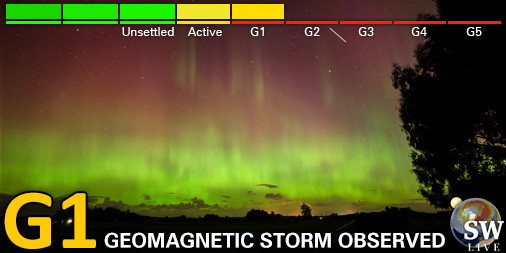Viewing archive of Monday, 2 October 2017
Daily bulletin on solar and geomagnetic activity from the SIDC
Issued: 2017 Oct 02 1230 UTC
SIDC Forecast
Solar flares
Quiet conditions (<50% probability of C-class flares)
Geomagnetism
Quiet (A<20 and K<4)
Solar protons
Quiet
| 10cm flux | Ap | |
|---|---|---|
| 02 Oct 2017 | 085 | 007 |
| 03 Oct 2017 | 084 | 007 |
| 04 Oct 2017 | 083 | 005 |
Bulletin
Solar activity was at very low levels. The 3 visible sunspot groups were quiet. The greater than 10 MeV proton flux was at nominal levels. Quiet flaring conditions are expected, with a small chance on a C-class flare.
Some coronal dimming was observed at S10W50 on 01 October between 14 and 17UT, followed by post-eruption coronal loops over and to the northwest of NOAA 2682. The x-ray flux seems to have been mildly enhanced in response to this eruptive event. Some coronal mass ejections (CMEs) were observed by SOHO/LASCO starting late on 01 October, but they were relatively slow (CACTus) and directed to the west (no obvious earth-directed component).
Solar wind speed varied between 430 and 500 km/s (DSCOVR), ending the period near 440 km/s. Bz varied between -5 and +2 nT (DSCOVR). The interplanetary magnetic field was mostly directed away from the Sun. A small negative equatorial coronal hole (CH) started transiting the central meridian on 01 October.
The geomagnetic field was at quiet to unsettled levels, with Kp featuring a single active episode during the 03-06UT interval. Quiet to unsettled geomagnetic conditions are expected, with an active episode still possible. The arrival of the particle stream associated with the aforementioned CH is expected for 04 or 05 October, with increasing chances on active geomagnetic conditions.
Today's estimated international sunspot number (ISN): 034, based on 21 stations.Solar indices for 01 Oct 2017
| Wolf number Catania | /// |
| 10cm solar flux | 086 |
| AK Chambon La Forêt | 021 |
| AK Wingst | 016 |
| Estimated Ap | 015 |
| Estimated international sunspot number | 037 - Based on 12 stations |
Noticeable events summary
| Day | Begin | Max | End | Loc | Strength | OP | 10cm | Catania/NOAA | Radio burst types | |
|---|---|---|---|---|---|---|---|---|---|---|
| None | ||||||||||
Provided by the Solar Influences Data analysis Center© - SIDC - Processed by SpaceWeatherLive
All times in UTC
Current data suggests there is a high possibility for aurora to appear at the following high latitude regions in the near future
Rovaniemi, Sodankylä, UtsjokiKirkenes, Tromsø
Murmansk
Kiruna
Current data suggests there is a moderate possibility for aurora to appear at the following high latitude regions in the near future
TórshavnOulu
Trondheim
Arkhangelsk, Vorkuta
Luleå, Umeå
Current data suggests there is a slight possibility for aurora to appear at the following high latitude regions in the near future
KuopioBergen, Oslo
Sundsvall
Current data suggests there is a slight possibility for aurora to appear at the following middle latitude regions in the near future
Helsinki, Tampere, TurkuPetrozavodsk, Syktyvkar
Latest news
Latest forum messages
Support SpaceWeatherLive.com!
A lot of people come to SpaceWeatherLive to follow the Sun's activity or if there is aurora to be seen, but with more traffic comes higher server costs. Consider a donation if you enjoy SpaceWeatherLive so we can keep the website online!

Latest alerts
21:03 UTC - Hemispheric Power Index
The OVATION model predicts the Hemispheric Power Index to reach 75GW at 21:49 UTC
13:15 UTC - Geomagnetic activity
Minor G1 geomagnetic storm (Kp5) Threshold Reached: 13:07 UTC
12:33 UTC - Hemispheric Power Index
The OVATION model predicts the Hemispheric Power Index to reach 75GW at 13:21 UTC
00:15 UTC - Geomagnetic activity
Minor G1 geomagnetic storm (Kp5) Threshold Reached: 23:59 UTC
Thursday, 3 April 2025
20:15 UTC - Geomagnetic activity
Minor G1 geomagnetic storm (Kp5) Threshold Reached: 20:02 UTC
Space weather facts
| Last X-flare | 2025/03/28 | X1.1 |
| Last M-flare | 2025/04/01 | M2.5 |
| Last geomagnetic storm | 2025/03/27 | Kp5 (G1) |
| Spotless days | |
|---|---|
| Last spotless day | 2022/06/08 |
| Monthly mean Sunspot Number | |
|---|---|
| March 2025 | 134.2 -20.4 |
| April 2025 | 143 +8.8 |
| Last 30 days | 130.4 -16.1 |





